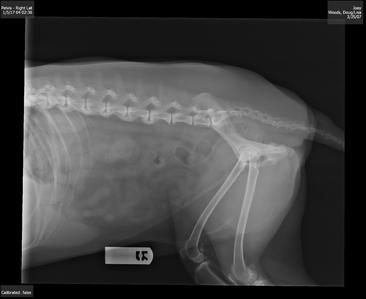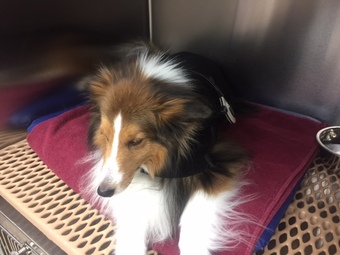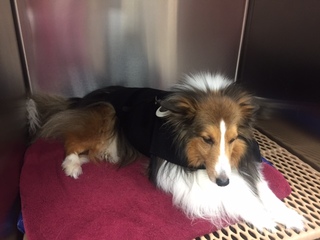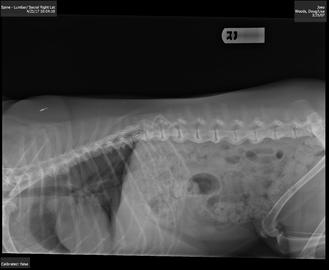Not only is Lisa Woods a dedicated pet owner, but she’s also a veterinary technician. So when her 10-year-old Shetland sheepdog Joey was having difficulty standing, particularly on hard surfaces, she knew his pain and weakness needed to be diagnosed and treated.

Under the guidance of her vet and colleague Dr. Darryl King of Companion Animal Hospital in Collierville, Tennessee, Lisa found that Joey had mild to severe spondylosis deformans in his spine and hips, particularly on the right side. While the cause of spondylosis deformans can vary, the effects are pronounced: Bone spurs form at the edges of the vertebrae, causing decreased mobility and pain. As of his first x-rays on January 5, 2017, Joey was no longer jumping off the furniture and had been gradually worsening over the last three to four months.
Joey started on a regimen of Carprofen, a non-steroidal anti-inflammatory drug, as well as Adequan injections. Until April 4, he also got twice-weekly therapeutic cold laser treatments. On April 14, Dr. King and Lisa opted to stop the other therapies and treat exclusively with the Assisi Loop. Joey received four treatments per day each on his neck and his lower back.
Lisa does all of the product ordering for Companion Animal Hospital. After ordering Assisi Loops for some of their veterinary clients she became curious about the device as a therapy for dogs. “You know, we were a little skeptical from the beginning, even though the information is good.” she said, “… And surprisingly it worked, and it worked quickly.”
Dr. King concurs: “I was quite surprised at Joey’s response to it,” he tells Assisi. “I didn’t expect him to be unhappy with it at all, but I was surprised that it was as positive as it was.”
 Not only was the Loop able to replace the two medications and laser therapy for Joey, but Joey found relief fast. “I thought we were probably not going to see any results for a few weeks,” Lisa recalls, “but we did see some results after the first five to seven days. … It was amazing.” While Joey is generally pretty calm for a Sheltie, Lisa also noted how the Loop relaxed him even further. “He would almost fall asleep. It was amazing when he was actually having therapy done, how different his behavior was.”
Not only was the Loop able to replace the two medications and laser therapy for Joey, but Joey found relief fast. “I thought we were probably not going to see any results for a few weeks,” Lisa recalls, “but we did see some results after the first five to seven days. … It was amazing.” While Joey is generally pretty calm for a Sheltie, Lisa also noted how the Loop relaxed him even further. “He would almost fall asleep. It was amazing when he was actually having therapy done, how different his behavior was.”
Dr. King saw the difference in Joey, too – and was especially impressed since, in his experience, animals don’t usually fully relax in the doctor’s presence. “He almost looked like a person who was daydreaming,” he says of Joey during his Loop treatment, “and so there was definitely no doubt that he was very, very comfortable. It was extremely calming for him, and it must have been a very pleasant experience as far as he’s concerned.”
Additionally, Lisa says, “the LOOP-AID really helped us position the Loop, especially over his back area. It was fairly easy to do his neck because the Loop is big enough to be like a necklace, but his back would have been a little bit of a challenge had we not have had the wrap.”
Joey Before The Loop
After about a month, Lisa found she could reduce Joey’s treatments. “Initially we were doing both areas four times a day,” she says of his neck and lumbar spine. “Then we stepped it down to where we were doing both areas twice a day. … We tried to keep it about the same time of the day and the same number of treatments a day. I think in the video, it’s pretty amazing how he was kind of gimpy initially, and then after we treated him he’s running around like nothing’s going on.” Indeed, in Joey’s “before” video, his gait is choppy and hesitant; in the “after,” he navigates the house comfortably and smoothly.

Lisa also noticed that much of Joey’s joie de vivre had returned. In the car, she said, whereas he used to just lie down quietly as he rode, “one morning I was bringing him into work and he jumped back and forth between the back seat and the front seat. I have not seen him willing to do that in a long time. … Just some little things like that. He was not as reluctant to do some of these behaviors that he’s been reluctant to do in the past. I think he feels better.”
For many clients at the animal hospital, Lisa feels that therapeutic laser, while effective, can get cost-prohibitive, especially for more severe conditions like Joey’s that require more treatments. Additionally, “there has to be that client compliance,” Lisa says. “I think if the client has the ability to do something at home, they feel like they’re more involved in it. Also, it is more of a convenience factor for the owner, so they’re more willing to do it.”
Overall, Lisa was relieved to be able to move away from pharmaceuticals. “I know what long-term NSAIDs can do and I would prefer not to go down that road until we have to at some point,” she says.
 Joey certainly seems thankful as well. Dr. King said that Joey can get nervous at the vet hospital, and sometimes walks in circles when he is anxious. “But when he saw the Loop in your hand, there was no circling. It was just standing up walking towards you like, ‘Hey, are you going to do that again?'” Lisa says, “We laugh at Joey -I don’t know if this thing is addictive or not, but he acts like it is. He sees you get the Loop out and he comes running. It’s like he knows he’s going to feel better when he has it done.”
Joey certainly seems thankful as well. Dr. King said that Joey can get nervous at the vet hospital, and sometimes walks in circles when he is anxious. “But when he saw the Loop in your hand, there was no circling. It was just standing up walking towards you like, ‘Hey, are you going to do that again?'” Lisa says, “We laugh at Joey -I don’t know if this thing is addictive or not, but he acts like it is. He sees you get the Loop out and he comes running. It’s like he knows he’s going to feel better when he has it done.”
As a veterinary technician, as well, Lisa feels more comfortable recommending the Loop to the hospital’s clients after seeing how much it helped Joey. “It’s so much easier to talk to a client when it’s something you have hands-on experience with like we had with Joey,” she says. “A big selling point would be how much better he seemed to feel. For most people, if their pet’s physically feeling better, whatever they can do to make that happen, they’re going to do.”
Overall, Dr. King is confident that the Loop will find a place in his practice as part of a multi-modal approach. “I think I will have some clients that are interested in it and so it is definitely something that we will recommend,” he says, “especially for some of the ones that either are not tolerating NSAIDs or are already on a pretty good dose of medications. … More and more people are open to non-typical treatments, and I think that is a great thing.”
Joey After The Loop
